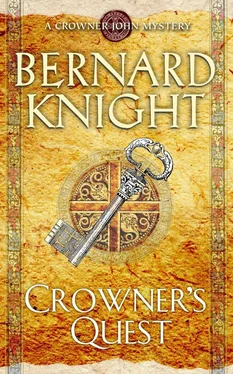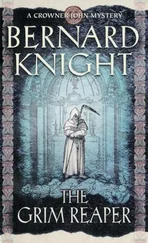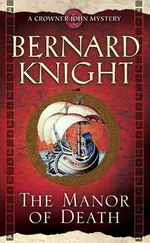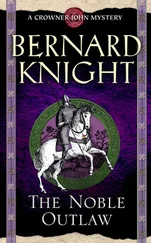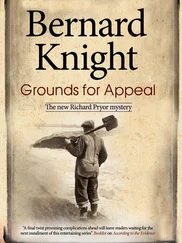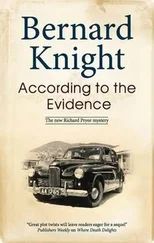Bernard Knight - Crowner's Quest
Здесь есть возможность читать онлайн «Bernard Knight - Crowner's Quest» весь текст электронной книги совершенно бесплатно (целиком полную версию без сокращений). В некоторых случаях можно слушать аудио, скачать через торрент в формате fb2 и присутствует краткое содержание. Год выпуска: 2014, Издательство: Severn House Digital, Жанр: Исторический детектив, на английском языке. Описание произведения, (предисловие) а так же отзывы посетителей доступны на портале библиотеки ЛибКат.
- Название:Crowner's Quest
- Автор:
- Издательство:Severn House Digital
- Жанр:
- Год:2014
- ISBN:нет данных
- Рейтинг книги:5 / 5. Голосов: 1
-
Избранное:Добавить в избранное
- Отзывы:
-
Ваша оценка:
- 100
- 1
- 2
- 3
- 4
- 5
Crowner's Quest: краткое содержание, описание и аннотация
Предлагаем к чтению аннотацию, описание, краткое содержание или предисловие (зависит от того, что написал сам автор книги «Crowner's Quest»). Если вы не нашли необходимую информацию о книге — напишите в комментариях, мы постараемся отыскать её.
Crowner's Quest — читать онлайн бесплатно полную книгу (весь текст) целиком
Ниже представлен текст книги, разбитый по страницам. Система сохранения места последней прочитанной страницы, позволяет с удобством читать онлайн бесплатно книгу «Crowner's Quest», без необходимости каждый раз заново искать на чём Вы остановились. Поставьте закладку, и сможете в любой момент перейти на страницу, на которой закончили чтение.
Интервал:
Закладка:
Bernard Knight
Crowner's Quest
Glossary
ABJURER
A criminal or accused person who sought sanctuary in a church and then elected to ‘abjure’ by confessing his sin to the coroner and leaving the realm of England for ever, to avoid being mutilated or hanged. He had to proceed on foot, dressed in sackcloth and carrying a wooden cross, to a port nominated by the coroner and take the first ship abroad. If there was a delay, he had to wade out up to his knees in every tide, to show his willingness to leave.
ALB
A long garment, often elaborately embroidered, worn by priests when celebrating Mass, under a shorter garment called the chasuble ( q.v. ).
AMERCEMENT
A fine imposed on a person or a village by the coroner, for some breach of the complex regulations of the law. The coroner would record the amercement, but the collection of the money would be ordered by the King’s Justices, when they visited at the Eyre of Assize ( q.v. ).
APPEAL
Unlike the modern legal meaning, an Appeal was an accusation by an aggrieved person, usually a close relative, against another for a felonious crime. The remedy was either financial compensation, trial by combat or undergoing the Ordeal. Historically, it preceded (and in the twelfth century, competed with) the Crown’s right to prosecute.
ARCHDEACON
A senior cathedral priest, assistant to the Bishop. There were four in the diocese of Devon and Cornwall, one responsible for Exeter.
ASSART
A new piece of arable land, cut from the forest to enlarge the cultivated area of a manor.
AVENTAIL
A chain-mail neck armour, similar to a balaclava, attached to the edge of the helmet and tucked in to the top of the hauberk ( q.v. ).
BAILEY
The outer enclosure of an early Norman castle of the ‘motte and bailey’ type. An artificial mound was thrown up and a wooden tower erected on top (donjon q.v. ). Around its base, usually asymmetrically, a ditch and stockade demarcated the bailey, in which huts were erected for living quarters, kitchens, etc., the donjon being used as an inner refuge during siege.
BAILIFF
Overseer of a manor or estate, directing the farming and other work. He would have manor reeves under him and in turn be responsible to either his lord or the steward or seneschal.
BALDRIC
A diagonal strap over the right shoulder of a Norman soldier, to suspend his sword scabbard on the left hip.
BURGESS
A freeman of substance in a town or borough, usually a merchant. A group of burgesses ran the town administration and elected two Portreeves ( q.v. ) as their leaders, later replaced by a mayor.
CANON
A priestly member of the Chapter of a cathedral, also called a prebendary, as they derived their income from their prebend, a grant of land or a pension. Exeter had twenty-four canons, most of whom lived near the cathedral, though unlike the majority of other cathedrals, the canons were paid a small salary and had a daily allowance of bread, candles, etc. Many employed junior priests (vicars and secondaries) to carry out some of their duties.
CAPUCHON
Man’s headgear, consisting of a long length of cloth wound round the head like a loose turban, the free end hanging down to one shoulder.
CHAPTER
The administrative body of a cathedral, composed of the canons (prebendaries). They met daily to conduct business in the Chapter House, so-called because a chapter of the Gospels was read before each meeting.
CHASUBLE
A thigh-length garment, usually embroidered, with wide sleeves, worn over the alb ( q.v. ) by priests during the celebration of Mass.
CONSISTORY COURTS
The ecclesiastical courts, which had the right to try priests, rather the secular courts. Anyone who could read and write — even just sign their name — could claim to be tried by this court, as literacy was virtually confined to the clergy.
CONSTABLE
Has several meanings, but here refers to a senior military commander, usually the custodian of a castle — sometimes called a castellan. Appointed by the King in royal castles such as Exeter, to keep him independent of powerful local barons.
CORONER
A senior law officer in a county, second only to the sheriff. First appointed in September 1194, though there are a few mentions of coroners in earlier times. Three knights and one clerk were appointed in every county. The name comes from the Latin custos placitorum coronae , meaning ‘Keeper of the Pleas of the Crown’, as he recorded all serious crimes, deaths and legal events for the Royal Justices in Eyre ( q.v. )
COVER-CHIEF
Headdress of a Norman woman, more correctly called a couvre-chef . In Saxon times it was known as a head-rail and consisted of a linen cloth held in place by a circlet or band around the forehead, the ends hanging down over the back and bosom.
CROFT
A small area of land around a village house for vegetables and few livestock, used by the occupant (cottar) who was either a freeman or a bondsman (villein or serf).
CUIRASS
A breastplate or short tunic, originally of thick boiled leather but later of metal, to protect the chest in combat.
DEODAND
Literally ‘a gift from God’, it was the forfeiture of anything that had caused a death, such as a sword, a cart or even a mill-wheel. It was confiscated by the coroner for the King, but was sometimes given as compensation to a victim’s family.
DONJON
The central fortified tower in early Norman castles, later called the keep. Originally of wood, it was soon replaced by masonry. The word dungeon, meaning a prison cell in the base of a castle tower, is a later derivative of donjon.
EYRE
A sitting of the King’s Justices, introduced by Henry II in 1166, which moved around the country in circuits. There were two types, the ‘Justices in Eyre’, the forerunner of the Assizes, which was supposed to visit frequently to try serious cases, and the General Eyre, which arrived at long intervals to check on the administration of each county.
FIRST FINDER
The first person to discover the corpse of a slain victim or to witness a crime, had to rouse the four nearest households and give chase to the culprit (the hue and cry). Failure to do so would result in an amercement ( q.v. ) by the coroner.
HAUBERK
Also called a byrnie, this was a chain-mail tunic with long sleeves, to protect the wearer from neck to calf; the skirt was usually slit front and back to allow him to ride a horse.
HIDE
A medieval measure of land, which varied from place to place, but was usually 120 acres at the time of the Domesday survey, but later quoted at anything between 30 and 80 acres. A hide was supposed to be enough to support a family and was divided into four virgates. Another land measure was the carucate, about 100 acres, the area that one ox-team could plough in a season.
HONOUR
A holding of land from the King, baron or Church. It might be a large estate or a single manor and many honours consisted of numerous separate holdings spread over many counties. A manor might be one village or several, under the same lord. Some villages were split between different lords.
HUE AND CRY
When a crime was witnessed or discovered, the First Finder ( q.v. ) had to knock up the four nearest houses and give chase to any suspects.
JURY
Unlike modern juries, who must be totally impartial, the medieval jury included witnesses, local people who were obliged to gather to tell what they knew of a crime or dispute. The coroner’s jury was supposed to consist of all the men over the age of twelve from the four nearest villages, though this was often a practical impossibility.
Читать дальшеИнтервал:
Закладка:
Похожие книги на «Crowner's Quest»
Представляем Вашему вниманию похожие книги на «Crowner's Quest» списком для выбора. Мы отобрали схожую по названию и смыслу литературу в надежде предоставить читателям больше вариантов отыскать новые, интересные, ещё непрочитанные произведения.
Обсуждение, отзывы о книге «Crowner's Quest» и просто собственные мнения читателей. Оставьте ваши комментарии, напишите, что Вы думаете о произведении, его смысле или главных героях. Укажите что конкретно понравилось, а что нет, и почему Вы так считаете.
